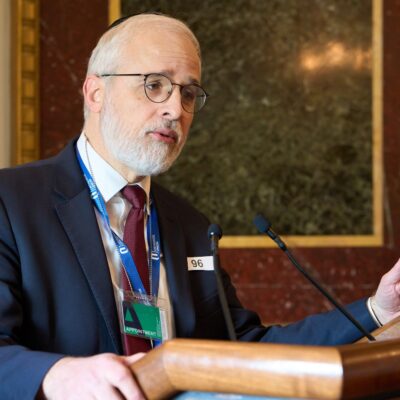Year in review
Study: Charitable giving dropped in 2022; only the fourth such decline in 40 years
Giving USA’s annual survey of philanthropic donations cites flailing stock market, high inflation in decline across all sectors

Sewcream/Getty Images
Philanthropic giving dropped in 2022, down more than 10% after adjusting for inflation from the previous year, according to an annual study by the Giving USA Foundation and Indiana University, which was released on Tuesday.
This is only the fourth time that charitable giving has decreased from the previous year in four decades. The previous instances – 1987, 2008 and 2009 – followed the Black Monday crash and the Great Recession, respectively.
The authors of the yearly study – Giving USA: The Annual Report on Philanthropy – calculated that individuals, bequests, foundations and corporations gave an estimated $499.33 billion to U.S. charities last year. This represents a 3.4% decline from 2021 – a record high year – when $516.65 billion was donated. Factoring in inflation, that $17.32 billion drop represents a 10.5% reduction, according to the study.
“Declines in giving like those we saw in 2022 have a tangible impact on nonprofit organizations, especially those that rely on charitable dollars to support their daily work,” Amir Pasic, dean of Indiana University’s Lilly Family School of Philanthropy, which co-authored the study, said in a statement. “Nonprofits and donors alike experienced the steady, negative impacts of inflation such as the growing cost of goods and high interest rates throughout 2022, and many of those challenges remain.”
The annual study, which is funded by Giving USA, is researched and written by the Indiana University Lilly Family School of Philanthropy at IUPUI, using a variety of economic analysis tools and data sets, including tax data, economic indicators and demographics. The figures presented in the study are estimates as the study is released “before final tax data, some economic indicators and some demographic data are available,” Giving USA said in a statement.
The findings are updated as final data become available. Last year’s initial study, for instance, calculated 2021 charitable giving at approximately $485 billion, when the final sum was found to be significantly higher: $516.65 billion. The estimates are reviewed by an external review panel, made up of academics and experts in the fields of philanthropy and the nonprofit sector.
The study’s authors identified four economic developments in 2022 that contributed to the estimated reduction: flat growth in disposable personal income; 40-year-high inflation rate of 8.0%; a 19.4% drop in the S&P 500, which they said created “economic uncertainty for high-net-worth households and foundations”; and the fact that the decline in the S&P 500 occurred at the end of the year, when charitable donations are more likely to take place.
When adjusted for inflation, charitable giving decreased from all sources in 2022, albeit to different extents. Donations by individuals dropped the most, down 13.4% when adjusted for inflation, compared to a 5.3% drop in gifts made through wills or trusts, a 5% drop by foundations and a 4.2% drop from corporations.
“Households were heavily impacted by economic uncertainty, the threat of recession, inflation, and changes in the stock market – and in turn, individual giving took the biggest hit of all in 2022,” Wendy McGrady, the secretary/treasurer of Giving USA Foundation and executive vice president and COO of The Curtis Group, said in a statement. “While in 2020 and 2021, giving was buoyed by stock market performance, in 2022, it appears individual donors were impacted by changing economic conditions.”
Not all of these are necessarily or solely the result of the economic downturn, however. Individual giving has been on the decline for decades as high-net-worth people opt for other vehicles for philanthropic giving, particularly donor-advised funds and family foundations.
“Individual giving has been declining as a share of total giving for several years. It dropped to 70% of total giving in 2018, which was considered low, and has steadily decreased since then, falling further in 2022 to 64%,” McGrady wrote.
Writing in eJewishPhilanthropy last year about the 2021 Giving USA report, Avrum Lapin, president of the Lapin Group consulting firm and a board member of the Giving Institute, which funds Giving USA, explained that the tax benefits of other philanthropic tools were behind this shift away from individual donations.
“Donor-advised funds have clear tax advantages for donors, and they are less regulated than other foundations. As noted, a ‘traditional’ foundation is required to allocate a certain percentage of its asset each year, while donor advised funds can sit fallow,” Lapin wrote.
Zooming out slightly, the study’s authors noted that despite the drop in 2022, charitable giving by foundations and corporations has grown over the past two years, even when adjusting for inflation.
In line with this trend, donations to foundations increased by 1.9% in 2022 when adjusted for inflation, despite the decline in almost all other sectors. Recipients related to international affairs were the only other group to see a rise in 2022 donations when adjusted for inflation, up 2.7% from the previous year.
The hardest hit, or perhaps least helped, recipients were in “public-society benefit,” which saw a 15.2% decrease, accounting for inflation. Education-related recipients also saw a double-digit decrease, down 10.7%. Donations to “environment and animals” recipients dropped by 8.9%, human services by 8%, arts culture and humanities by 4.7% and both health and religion recipients saw decreases of 2.6%, according to the study.
Last year was also the second in a row in which very large donations – more than $450 million – by ultrawealthy individuals or couples represented approximately 5% of total donations. Gifts by six individuals or couples alone represented $13.96 billion, or 2.8%, of the total amount donated last year.
Looking at the brighter side, Josh Birkholz, the chair of Giving USA Foundation and CEO of BWF, said that the situation could have been far worse in light of the economic downturn in 2022.
“Drops in the stock market and high inflation caused many households to make tough decisions about their charitable giving for the year,” Birkholz said in a statement. “But despite uncertain economic times, Americans demonstrated how essential they view the nonprofit sector and its ability to solve big problems — by still giving nearly half a trillion dollars in 2022.”
Pasic, dean of the Lilly Family School of Philanthropy, was also optimistic, citing precedents: “Giving USA’s historical data also provide a case for hope: we have seen charitable giving rebound from each decline.”

 Add EJP on Google
Add EJP on Google









